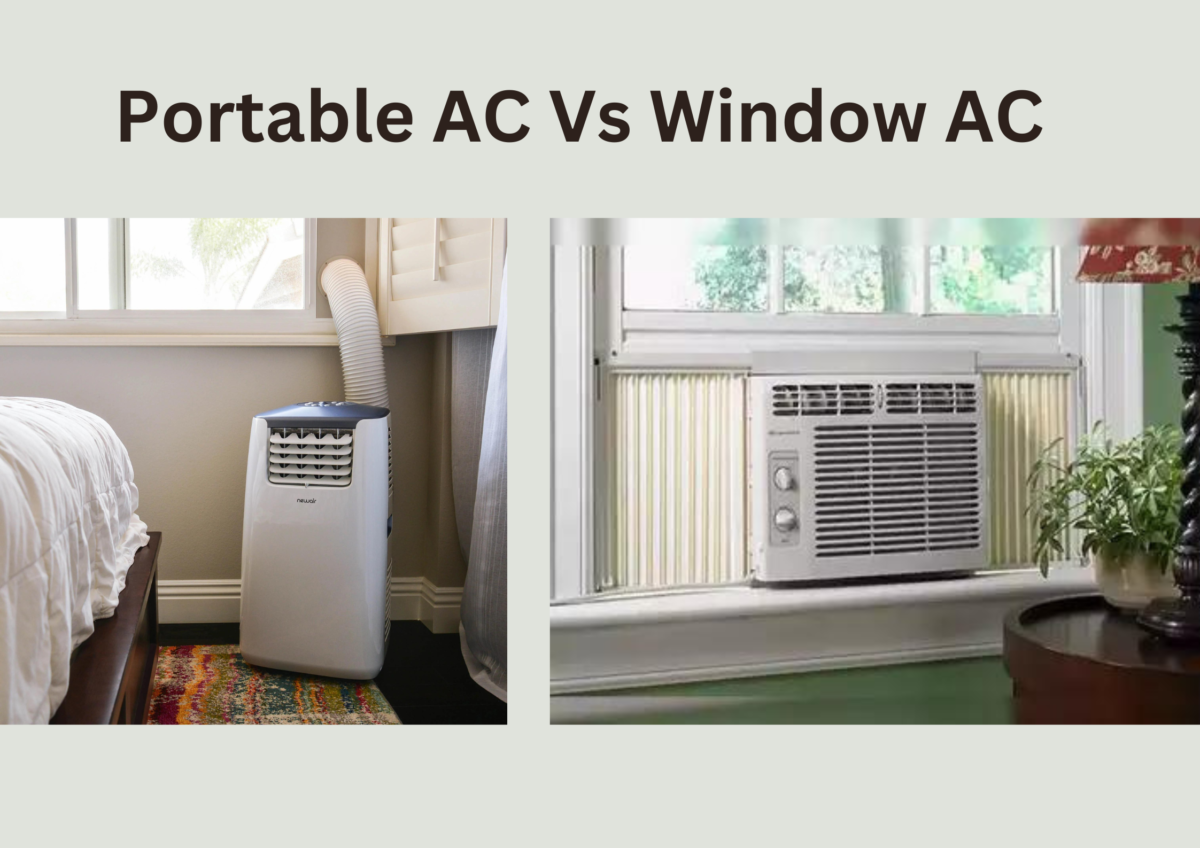If you want to cool down a single room or any specific area inside your home, then portable AC and window AC are the two most popular options available in the market. But which device is perfect for your home?
The basic working principle of both types of air conditioners is the same. When the indoor air passes over the cold refrigerant coils, the refrigerant inside it absorbs heat from the indoor air, making it cool. The cooled air is then circulated inside the room while blowing the hot air outside.
Each type of AC has its advantages and disadvantages. While purchasing the user must consider some major factors including the budget, size of the room, number of windows inside the room, etc. to make a correct decision.
Still getting confused between portable AC and window AC? This article explains in detail about “portable AC vs window AC” to point out some major differences between these two devices.
Definition (Portable AC Vs Window AC)
What Is a Portable AC?
A portable AC is a self-contained and entirely portable unit used to cool down a small space or, a single room. This flexible system can be easily transferred from one room to another. It consists of an evaporator coil, condenser coil, compressor, and a fan to circulate cool air inside the room. It also contains a hose pipe to exhaust the heat and moisture to the outdoor area. For this, you must have a way to channel the hose pipe to the outdoor area.

What Is a Window AC?
Window AC units are the simplest type of air conditioners positioned in the windows’ frames. This type of system consists of a fan which is placed inside the room to circulate cool air and the unit which releases the heat produced by the system is placed outside the home. These systems are perfect for cooling down a single room.

Working Principle (Portable AC Vs Window AC)
How Does a Portable AC Work?
- The main difference between a portable AC and a window AC is the latter consists of all the processing units together in one stand-alone device. It consists of a hose pipe to release the heat and moisture to the outdoor area.
- The fan inside the system absorbs the warm indoor air into it and passes it over the evaporator coil.
- The liquid refrigerant inside the evaporator coil absorbs the heat from the air, makes it cool and the cool air is circulated back inside the room.
- After absorbing the heat, the liquid refrigerant converts into gas and moves inside the compressor unit.
- The compressor compresses it into high-pressure high-temperature gas and sends it to the condenser Unit.
- The condensation process converts the gas to liquid form.
- The moisture and heat generated throughout the whole process need to be exhausted outside the home and this is executed by the hose pipe connected to the system.

How Does a Window AC Work?
- The blower inside the window AC unit draws in the warm indoor air inside the system.
- When the warm air passes through the cold refrigerant coils, the refrigerant inside it absorbs heat from the air and makes it cool. The cool air is then circulated throughout the room.
- The liquid refrigerant absorbs the heat from the air and gets converted into gaseous form. The refrigerant gas is then moved into the compressor unit.
- The compressor compresses the refrigerant gas and converts it into a high-pressure temperature gas.
- When the high-pressure temperature refrigerant gas passes over the condenser coil the condensation process starts and the refrigerant converts into liquid form. The condenser unit is placed outside the house. So, when the high-temperature refrigerant comes in contact with the environmental air it converts into liquid form.
- When the liquid refrigerant passes through the expansion valve its pressure decreases. Thus, the low-pressure liquid refrigerant again flows inside the evaporator coil to continue the process of cooling down a room.
Pros and Cons (Portable AC Vs Window AC)
Pros and Cons of Portable AC
Pros
- These devices can be easily transferrable from one room to another.
- The installation of a portable AC system is very easy and you can do it by yourself without taking help from any professionals.
- These devices are cheaper than other types of air conditioners.
- The smart features integrated with the system’s thermostat make its operation easy. You can control this device with your smartphone even if you are away from home.
Cons
- A portable AC is suitable for a small space or, a single room. They can’t efficiently cool down a large space.
- These devices are placed inside the home and can be quite noisy.
- The device requires proper ventilation to work efficiently. So, before installing it check if the room has any window or sliding door inside it or, not.
- For consistent performance the device needs proper maintenance.
Pros and Cons of Window AC
Pros
- A window AC system is highly effective in cooling down a small space or, a single room.
- You don’t have to worry about drainage as the unit placed outside the home drains the water easily.
- It consumes less energy and thus produces less electricity bill than a central AC unit.
- A window AC requires less maintenance to work efficiently. It only needs yearly servicing to maintain its efficiency.
Cons
- The installation of a window AC is a bit complex and you need to get help from professionals for this.
- By placing this device, you cannot enjoy the beautiful view out of your window.
- It’s not good from a security point of view as someone can easily enter your home through the window.
Cooling Capacity (Portable AC Vs Window AC)
Cooling Capacity of Portable AC
The cooling capacity of a portable AC is measured in BTUs (British Thermal Units). The higher the BTU value specified on the product, the more cooling capacity the system will have. A portable AC with a higher BTU value can cool a larger space. While purchasing, consider the cooling capacity of the AC that is appropriate for your space.
The cooling capacity of a portable AC based on different room sizes is represented in the table given below.
| Square Footage Size of Your Room | Cooling Capacity |
| 200 sq. ft. | 8000 BTUs |
| 300 sq. ft. | 10000 BTUS |
| 400 sq. ft. | 12000 BTUs |
| 500 sq. ft. | 14000 BTUs |
Cooling Capacity of Window AC
Always buy a window AC unit that has a BTU level designed to fit your room. A window AC with perfect BTU value improves efficiency and effectiveness. It can cool and dehumidify your room evenly without taking much time. If the cooling capacity does not match with square footage size of the room, it will take more time and energy to cool down the room.
| Square Footage Size of Your Room | Cooling Capacity |
| 250 – 300 sq. ft. | 7000 BTUs |
| 350 – 400 sq. ft. | 9000 BTUS |
| 400 – 450 sq. ft. | 10000 BTUs |
| 450 – 550 sq. ft. | 12000 BTUs |
Energy Efficiency (Portable AC Vs Window AC)
Energy Efficiency of Portable AC
The energy consumed by the portable AC is comparatively higher than other types of AC. In general, a portable AC with a cooling capacity of 8000 BTUs consumes power between 900 to 1100 watts.
The energy efficiency of a portable AC is measured by CEER (Combined Energy Efficiency Ratio) ratings. The CCER ratings of most portable ACs range between 6 to 10. Thus, the energy efficiency of a portable AC is less compared to other types of air conditioning systems.
Energy Efficiency of Window AC
Usually, the CEER rating of a window AC falls between 10 to 15. It consumes almost 500 watts to 1440 watts to run. If you need to cool a single room window ACs are highly efficient and cost effective.
Portability and Mobility (Portable AC Vs Window AC)
Portability and Mobility of Portable AC
Portable ACs are mounted on wheels and can be easily transferred from one room to another. The systems are lightweight so can be easily lifted. The compact size and mobility of portable AC make it a perfect choice for cooling down a single room.
Portability and Mobility of Window AC
Window ACs are less flexible and once installed cannot be easily moved from one room to another. The installation procedure of a window AC is complex and you need professionals to install it. It cools down a single room and can not be moved frequently from one room to another.
Cost (Portable AC Vs Window AC)
Cost of Portable AC
The average cost to run a portable AC unit is $0.12 to $0.21 per hour. Thus, the average cost per month is between $30 to $50. The average price of a portable AC ranges between $400 to $800.
Cost of Window AC
The average cost to run a window AC unit is $0.08 to $0.23 per hour. Thus, the average cost per month is between $20 to $55. The average price of a window AC ranges between $300 to $700.
Conclusion
From the installation and portability point of view, a portable AC is a more suitable option than a window AC. A portable AC is a self-contained device and can be easily transferrable from one room to another. A window AC is more efficient in cooling down a room and has high CEER ratings. This device doesn’t take up any of your floor space and also produces less noise than a potable AC.
FAQS
- Is a window AC better than a portable AC?
Yes, a window AC has higher CEER ratings than a portable AC. Thus, it consumes less power and produces less electricity bills. This device doesn’t take up any of your floor space and also produces less noise than a potable AC. But, after being installed in a window frame it cannot be easily transferred from one room to another.
2. Does portable AC use a lot of electricity?
Yes, a portable AC uses a lot of electricity. The CEER rating of a portable AC ranges between 6 to 10 which is comparatively less than other types of AC.
Also Read
- Portable AC Vs Central AC: Which One Is Right for You? 2024
- Is Central AC Good for Home?
- Why Are HVAC Systems So Expensive? 10 Most Common Reasons
- What Size of HVAC System Do I Need? 2024
- What Is the Most Efficient HVAC System and Why? 2024
- Types of HVAC Systems in Apartments 2024
- HVAC System Working Principle
- HVAC System Vs Air Conditioning System: 6 Major Differences
- What Are the Most Common Types of HVAC Systems? 2024
- 6 Types of HVAC Systems for Homes 2024
- How Does a Refrigerator Work? A Step-by-Step Guide 2024
- 8 Reasons Why Refrigerator Not Cooling and Solutions
- Side By Side Vs French Door Refrigerator 2024
- Counter Depth Refrigerator vs. Standard Refrigerator: Which One Is Better?
- Where Should I Place My Air Purifier? 2024
- How Do You Know If You Need an Air Purifier? 2024
- HEPA Air Purifier: Definition, Types, Uses, Efficiency, Working Principle
- Whole House Air Purifier: Types, Pros, Cons, Working Principle 2024
- Air Purifier Advantages and Disadvantages
- How Do Air Purifiers Help? 6 Benefits
- Whole House Dehumidifier: Types, Working Principle, Pros, Cons 2024
- How Does a Commercial Dehumidifier Work? 2024
- How Does a Dehumidifier Work? Types, Uses, Benefits 2024
- 10 Tips for Buying a Dehumidifier
- Dehumidifier Vs Air Purifier 2024


11 thoughts on “Portable AC Vs Window AC: Which One Is Right for You? 7 Major Differences”